Corsair K70 RGB Rapidfire Keyboard Review
Pros
Cons
Rating
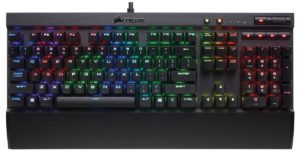
Introduction
Mechanical keyboards are all the rage nowadays, but the truth is that they’re nothing new. In fact, some of the best, most iconic keyboard ever sold for personal PC use were mechanical, including 1984’s IBM Keyboard Model M, which still sees a brisk trade in the used market. Luckily for enthusiasts looking for a style more fitting of this century, many of the PC industry’s top peripherals manufacturers have caught on to the trend, and that means there’s seemingly no end to the variety of new mechanical boards hitting the market.
Not too long ago, we did a thorough roundup of a number of the best keyboards on the market from the likes of Razer, Logitech, G.Skill, and Corsair. In that shootout, Corsair’s Strafe MX Red placed somewhere in the middle. Since then, we’ve also reviewed the latest and greatest offering from Cherry, the MX Board 6.0, which not surprisingly also used Cherry’s class-defining MX Red switches. It too failed to really knock our socks off. So we have to admit that when Corsair offered us the opportunity to check out its new K70 Rapidfire keyboard using MX Red Speed switches, we weren’t sure what to think. We knew MX Reds already provided a very quick response, but lacked the feedback we crave when we’re trying to get actual work done (like writing this review!).
But now, after having given Corsair’s K70 RGB Rapidfire a thorough workout, we get it. And we think you will too once you’ve read through our review! So let’s check out what the K70 RGB Rapidfire offers both in terms of features and performance!
We’d like to extend a special thank you to Corsair for providing us with a review sample of the K70 RGB Rapidfire Keyboard, along with the M65 Pro RGB Mouse and MM300 Extended Mouse Mat also mentioned in this article.
Description and Features
The K70’s basic design has been around for quite some time, and in fact is still the high-end board against which all others are judged. Part of that is due to its clean, uncluttered lines, compact size, and elegant brushed metal faceplate. In fact, at just 17.25″ wide and 6.5″ deep (or 8.5″ deep with the attached wristrest), the K70 is positively small for a performance keyboard, undercutting many standard office models due to its frameless design.
Of course, the K70 got a big helping hand from Corsair’s decision to go all-in with German switch manufacturer Cherry. Corsair was definitely on to something in sticking with Cherry even as demand outstripped supply and other keyboard manufacturers jumped ship (Logitech and Razer, we’re looking at you, and we know you’re looking back with shame!). Corsair is now Cherry’s biggest partner, and gets first dibs on some of Cherry’s most compelling new products, including its MX Silent switches, used in the limited-run Strafe RGB MX Silent, and now the MX Speed switches appearing in a number of Corsair’s products.
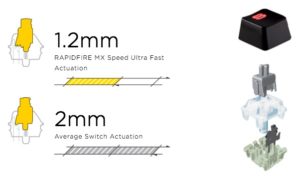
The key to the MX Speed (pun intended!) is a short 1.2mm throw, down from the 2mm of a standard MX Red. The actuation force has not changed (45 cN), nor has the lack of tactile feedback (which the MX Brown switch features) or audible click (which the MX Blue features). What this means is that nothing is going to stand in the way of you getting that key press recognized. We’ll talk more about the performance ramifications of this on the next page, but for now let’s explore that other headlining feature of the K70 RGB, its full-spectrum lighting.
Now, truth be told, we think the RGB craze is a bit over the top, with LEDs being added to everything from headsets (e.g., Corsair’s VOID RGB) to mousepads (e.g., Razer’s Firefly). Yes, the fact that LEDs can now display all the colors of the rainbox is kind of cool, but we have a feeling the novelty will wear off eventually, and we’ll get back to judging peripherals only by their comfort and performance. In the meantime, though, Corsair has the competition beat, with a huge array of stunning lightshow presets, which a few observers mentioned to us would work great at a rave. From our point of view, they work less well when you’re actually trying to use your PC, as the lights can be a distraction in your peripheral vision, and we really wish there were a way for the lightshow to only display when the PC is asleep, reverting back to something a bit more calming when you’re sitting at your desk.
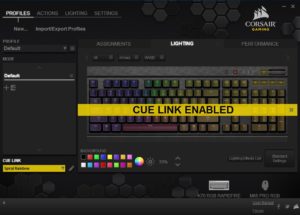
And that’s the fault we find in Corsair’s powerful CUE software: it allows you to do so much, but the options become dizzying, in part due to a lazy menu system, and then it leaves out what we think are obvious features that would really make the keyboard shine (literally). Ah well, some day Corsair will get around to a ground-up redesign of CUE, but for now, you can see what it looks like in the screenshot here, in which we’ve engaged CUE Link to synchronize the color shifting of the K70 RGB Rapidfire keyboard and the M65 Pro RGB mouse (which you can see in action on the next page). Note that CUE does not ship in the box – you’ll need to downloaded it from the Corsair website, and while it isn’t as critical for tuning performance as it is with a mouse, you won’t have any control over the LEDs until you install it.
Another feature that no good gaming keyboard can go without is a USB mouse pass-through, which helps prevent the dreaded mouse cord catching that occurs if you have to pull your mouse cable all the way down to your desktop’s I/O panel. And of course, the K70 has this, along with a thick braided cable sending two separate USB connectors out the back (a shared cable just wouldn’t cut it for two high-performance peripherals). Corsair has opted not to include a headphone and microphone pass-through, and this may irk some enthusiasts who likewise don’t enjoy having their head yanked back when their headset cord catches. If that sounds like you, check out G.Skill’s awesome KM780, which has been our favorite board for quite some time.
One last feature we should mention before we move on is the comfortable snap-on wrist rest. No keyboard at anywhere near this price should ship without one, and yet many of Corsair’s competitors continue to make this fatal error. We just don’t get it. Anyway, the K70’s wrist rest is easy to remove if you don’t like it, but chances are you will, as it’s raised just the right amount, has a comfortable surface that is slightly tacky without being sticky, and offers the slightest amount of cushion, meaning your hands will stay in place if you want them to.
Performance
We think it’s pretty critical that any test of high-speed peripherals is done on a machine that won’t slow things down, so we used an overclocked quad-core Skylake processor, a high-end video card, and a 144Hz G-Sync monitor. Our full setup was as follows:
- CPU: Intel Core i7-6700K (overclocked to 4.4GHz)
- Motherboard: Gigabyte GA-Z170X-Gaming 6 (thanks to Gigabyte and Newegg for providing this review sample)
- Memory: Corsair Vengeance LPX 2x8GB DDR4-3000
- Solid-State Drive #1: Samsung 850 Evo M.2 500GB
- Solid-State Drive #2: Crucial MX200 1TB
- Video Card: EVGA GeForce GTX 980 Ti SC 6GB
- Power Supply: EVGA Supernova 850 GS
- Case: Phanteks Enthoo Evolv ATX
- CPU Cooler: Noctua NH-U14S (thanks to Noctua for providing this review sample)
- Operating System: Windows 10 Home
- Monitor: Acer XB270HU 144Hz G-Sync
Honestly, if you’re even considering putting a ton of money into peripherals to improve your gaming experience, you absolutely must have a 144Hz and/or a G-Sync/FreeSync monitor. If you don’t, you’ll just continue to experience maddening, unexplained lag that will have you pounding your keyboard and mouse in frustration.
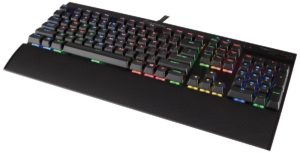
We’re going to split up our coverage of the K70 Rapidfire’s performance into two distinct discussions, as its ultra-responsive nature is really a double-edged sword. Sometimes you want it, sometimes you don’t. As background, when we did our mechanical keyboard round-up, we tried four keyboards using four different switch types: Cherry MX Red, Cherry MX Brown, Logitech’s Romer-G, and Razer’s Green (a Cherry MX Red clone). Interestingly, the model that placed last in our roundup was Logitech’s G410 Atlas Spectrum, using Romer-G switches, which happen to have a shortened 1.5mm stroke. In our opinion, it’s obvious that the Cherry MX Speed 1.2mm switch is a response to Logitech’s Romer-G. We don’t think they’re better than MX Reds, but apparently Cherry wasn’t taking any chances.
So, have Cherry and Corsair actually improved upon the gold standard, or are they just throwing around more marketing hype? Well, let’s get the bad part out of the way first. Cherry MX Speed switches are based on Cherry MX Reds, and MX Reds, as used in the Corsair Strafe and Cherry MX 6.0 Board that we’ve already tested, just aren’t that great for typing on. That’s because they don’t have a tactile bump in the middle of the stroke to give you feedback regarding actuation. You only know they’ve been depressed if you bottom them out, which isn’t a great technique for fast typing. Another drawback to the lack of a tactile bump is that you can’t rest your fingers on the keys without causing unintentional key presses. Resting fingers on keys probably isn’t perfect typing technique either, but when you’re in the middle of a thought, sometimes you just can’t help but let your fingers relax a bit.
And sure enough, the MX Speed switches in the K70 Rapidfire make this drawback even more pronounced. Countless times we found a sentence full of “ssssssssssssssssssss” galloping across our screen. So, to be frank, the keyboard just isn’t ideal for accurate typing. That being said, we actually like it more than MX Red-based boards for productivity use. Why? Because it’s so darn fast! When we’re really on a roll, hitting upwards of 80 words per minute (which we just benchmarked here!), the ultra-fast actuation of MX Speed switches makes a difference. And of course when we’re typing that fast, we’re not doing a lot of sitting around pondering what we’re going to type next, so the inability to rest fingers on the keys isn’t an issue. Finally, due to the ultra-short stroke, pretty much every keypress bottoms out, so for better or for worse, you get some tactile feedback.
OK, now let’s move on and talk about gaming performance, because that’s what this board is really all about. We gave this thing a serious drubbing in some intense Battlefield 4 multi-player matches, and folks, this is the only board you’ll want to use if you need the ultimate in twitch-gaming response. That short stroke makes so much sense in this scenario, and it actually makes clear that MX Red switches were always a compromise for gamers, being saddled as they were with a decades-old design that was optimized for typing, not gaming, modified with regard to actuation force and feedback, but not stroke. Cherry has gone back to the drawing board with the MX Speed switches and made up for decades of design imperfection. Until we have a dedicated gaming peripheral that takes over for what’s essentially a glorified typewriter, MX Speed switches are what you’re going to want to use for competitive gaming. The issue of accidental double-taps isn’t usually problematic in gaming, but if you play games where double-taps might be detrimental, you’ll want to stay away from this board, because double-tapping (and triple, quadruple, or quintuple-tapping) is going to be hard to avoid in the heat of the battle.
Before we get to our conclusion, we’ll leave you with a glamour shot of the K70 RGB Rapidfire, set to light up in sync with the M65 Pro RGB Mouse using CUE Link, pictured with the excellent Corsair MM300 Extended Mouse Mat as a backdrop.
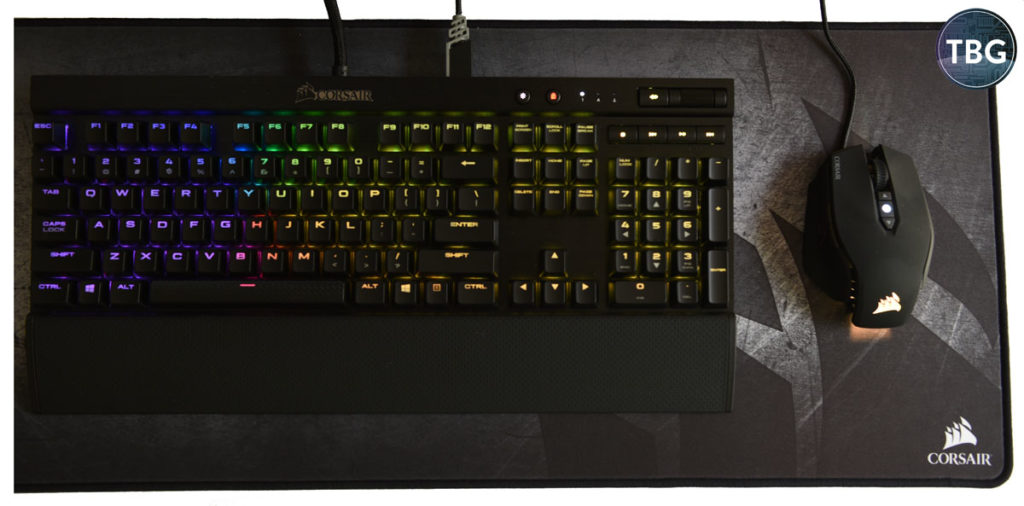
Conclusion
Circling back a bit, you may recall that we sounded a sour note about RGB lighting on the first page, suggesting that it was a fad whose time shall soon pass. But after spending some time with the K70 RGB Rapidfire, we’ve come to appreciate its finer points. We still don’t think that a keyboard lit up like a disco ball is what the typical well-heeled gamer (i.e., the kind most likely to spring for a $170 box of springs) wants. What these consumers probably do want, however, are options. And the K70 RGB Rapidfire definitely gives them that. Take, for instance, the photo below, which is how we set up our K70 once we’d captured the color-soaked image shown above. We’re kind of suckers for white LEDs, and sure enough, the K70 serves up a pretty good approximation of white backlighting. Look closely and you’ll see hints of green and red, and that’s no lens artifact. For whatever reason, they do indeed show through. But it’s better than the “white” LED lighting we managed to achieve on our M65 Pro RGB mouse, which ended up being a light blue.
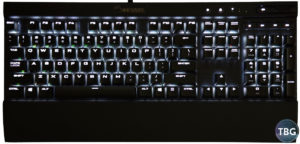
So, yeah, we kind of like the lighting after all. And while the MX Speed switches, based off of the popular MX Red models, don’t surpass MX Browns for accurate typing, they are glorious when it comes to gaming. Simply put, they provide the best gaming feel we’ve ever experienced. And of all of the keyboard designs on the market, the K70 is by far our favorite, easily out-classing the Corsair Strafe along with the offerings from Logitech, Razer, G.Skill, and the rest, providing a compact frame without omitting any of the most critical keys or the all-important wrist rest. Adding ultra-fast switches and slick lighting to this instant classic of a keyboard only makes it stand out even more from the field.
The Corsair K70 RGB Rapidfire Keyboard is available for $169.99 shipped from Amazon, as our publication date, and earns a spot as the ultimate gaming keyboard in our Peripherals Buyer’s Guide, which is updated quarterly with all the best products at every price point!

